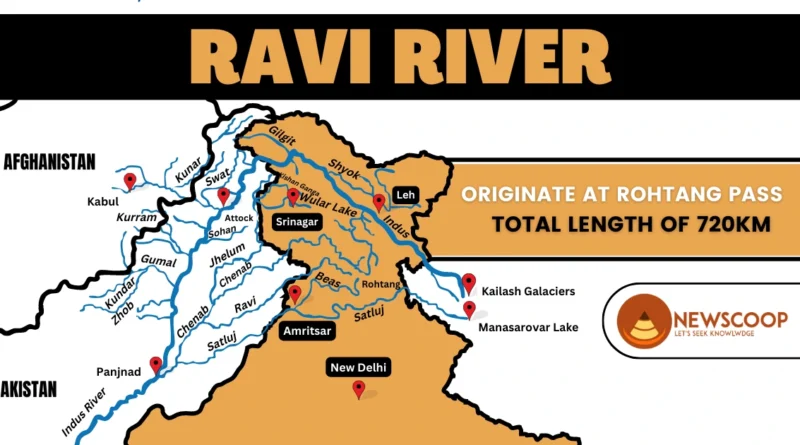Ravi River System: Map & Origin | Dams & Tributaries
The Ravi River is one of the five major rivers of the Punjab region in South Asia and holds significant historical, cultural, and ecological importance. Flowing through India and Pakistan, the river has played a pivotal role in shaping the civilizations that emerged along its banks and continues to be an essential water resource for millions of people in the region.
In this article, we delve into the multifaceted nature of the Ravi River, exploring its geographical features, historical legacy, ecological importance, and the challenges it faces in the present era. Aspirants of the UPSC (Union Public Service Commission) examination must understand the complexities surrounding this vital waterway, as it often appears in questions related to geography, history, and regional cooperation.
Geographical Features of Ravi River
The Ravi River boasts diverse geographical features along its course, influenced by the terrain through which it flows. From its origin in the Himalayas to its confluence with the Chenab River, the Ravi River showcases a mix of high-altitude landscapes and fertile plains. Here are some of the key geographical features of the Ravi River:
Origin
The Ravi River originates in the Kullu hills of Himachal Pradesh, near the Rohtang Pass. The point of convergence is situated near the Rohtang Pass, at an elevation of approximately 4,250 meters (13,944 feet) above sea level.
The Course of River Ravi
Flow Past Chamba and Dalhousie: The main Ravi River gracefully flows past the picturesque town of Chamba and through the base of Dalhousie Hill. At an altitude of 856 meters, the river was once spanned by a long wooden bridge, adding to the charm of the landscape.
Gorge in Dhauladhar Range: As it makes its way towards the Punjab plain, the Ravi River carves a stunning gorge in the Dhauladhar Range, creating a captivating natural feature that adds to the beauty of the region.
Indo-Pak Border and Length: Traversing approximately 80 kilometers along the Indo-Pak border, the Ravi River enters Pakistan and eventually joins the Chenab River. In total, the main Ravi River stretches for about 725 kilometers, influencing the landscapes and livelihoods along its course.
Ujh River – A Significant Tributary: The Ujh River, another major tributary of the Ravi River, originates in the Kailash Mountains near the Bhaderwah Mountains in Jammu district, at an elevation of 4,300 meters. After meandering for 100 kilometers, it meets the Ravi River at Nainkot, Pakistan.
River of Lahore: The Ravi River is fondly known as “The River of Lahore” as it flows past the historic city of Lahore, Pakistan. Located 26 kilometers below Amritsar, India, on its eastern bank, the river adds to the city’s cultural and scenic splendor.
Tombs of Jahangir and Noor Jahan: On the western bank of the Ravi River lies the town of Shahdara Bagh, which houses the captivating Tombs of Jahangir and Noor Jahan, representing the rich historical heritage of the region.
The main Ravi River journey is a captivating tale of natural beauty, historical significance, and cultural heritage. As it flows through diverse landscapes and past iconic landmarks, the river continues to nurture the land and the people who depend on its life-giving waters.
Dams on the Ravi River
The following are the dams on the Ravi River:
- Thein Dam (Ranjit Sagar Dam)
- Shahpurkandi Dam
- Ravi-Beas Link (Proposed)
- Chamera Dam
- Ujh Dam
- Upper Bari Doab Canal
Tributaries of the Ravi River
1. Budhil River
- It Originates in the Lahul range of hills in the Himalayas.
- Receives water from Manimahesh Kailash Peak and Manimahesh Lake, sacred Hindu pilgrimage sites.
- Flows for 72 kilometers with a steep slope of 314 feet per mile.
- Flows through Bharmour, an ancient capital now known as Bharmwar.
2. Nai River (Dhona)
- Rises at Kali Debi pass and joins the Ravi River after flowing for 48 kilometers from its source at Trilokinath.
- Has a bed slope of 366 feet per mile.
3. Seul River
- Flows from the north and meets the Ravi River just below Bharmour, the old capital of Chamba.
- Abundant timber trees were exploited in the Seul River valley.
- Known as “the garden of Chamba” due to large fertile terraces supporting crop cultivation.
4. Seva River
- Joins the Ravi near Basohli in Jammu and Kashmir.
- Exploited forest resources under the control of the then Raja of Chamba.
- Baira-Nalla, a major tributary, is part of the Seva River valley.
5. Tant Gari
- A small tributary of the Pir Panjal Range, rising east of Bharmour.
- Forms a U-shaped valley with a riverbed scattered with boulders and glacial deposits.
These tributaries, originating from various parts of the Himalayas, contribute to the flow of the River, enriching the region’s landscape and providing valuable resources for the communities that depend on it.
Historical Significance
The River holds a rich historical legacy, dating back to ancient times. Its banks were home to several significant civilizations, including the Harappan or Indus Valley Civilization (c. 3300–1300 BCE). Archaeological excavations along the river have revealed the existence of well-planned cities, advanced infrastructure, and a sophisticated urban life that thrived thousands of years ago.
Later, the region witnessed the rise and fall of various empires and dynasties, each leaving its mark on the cultural landscape. The Maurya, Gupta, Kushan, and Mughal empires all held sway over different parts of the Ravi River basin at various times in history. Their art, architecture, and governance contributions have enriched the region’s heritage.
Conclusion
The Ravi River stands as a testament to the interwoven nature of history, culture, and ecology in South Asia. Its journey from the lofty Himalayas to the plains of Punjab has witnessed the rise and fall of civilizations and continues to be a vital source of life and livelihood for millions.
Preserving this lifeline requires sustained efforts from governments, communities, and individuals on both sides of the border, ensuring that the Ravi River remains a symbol of unity and shared heritage for generations to come.
Thank You!

